Magneto
Since
the beginning of the last decade we are assisting to a dramatic industrial
depression, a result of unfortunate consequences rather unpredictable.
It has a strong effected on industrial sectors like the automotive which
seems immerged in a very deep and upsetting status, in other words not
really willing of new changes.
However only some of the most important car’s brands are really
concerning about this situation that involves this industrial sector
but without any apparent solution in order to restart in some way the
market. GM as well many other automotive brands are
still design new model, every year, issuing new cars in a very short
time and in many different styles, at such speed that the market isn’t
capable to absorb a such large variety of type and models, indeed as
a matter of effect today's cars look almost all the same.
This paranoid tendency seem to be quite unfruitful since the medium
consumer is still looking “unsuccessfully” for something
very new and really revolutionary; that means in few words: a new kind
of engine, with a low consumption and capable of very high performance
at same time. A car not necessarily need of burning conventional fuel
but something capable to get power through other power sources, according
with the use of conventional endothermic engines eventually
connected to a generator.
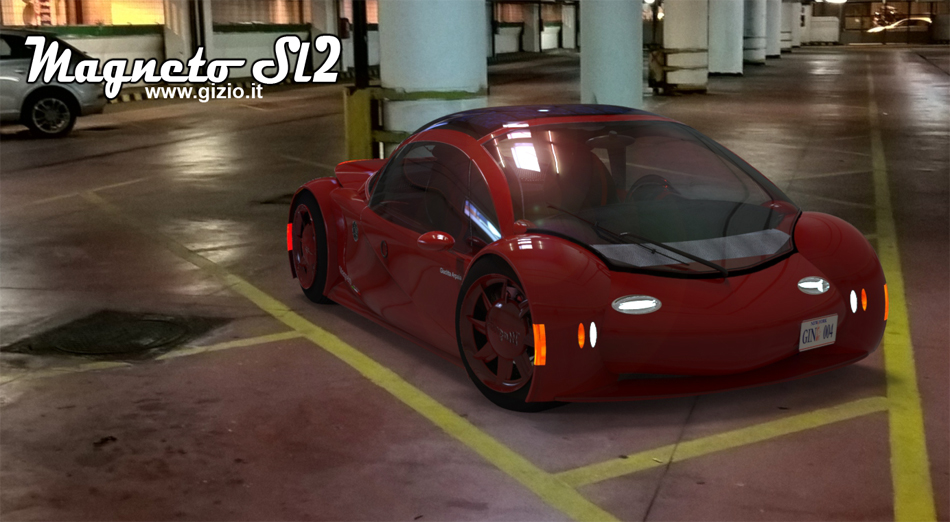
In order to fight and be competitive to those who will make low cost cars, with a very arguable quality, probably the market will be immerged in a sort of standardization of style and technology, we should revisiting our tech policy with new perspectives rebuilting the concept of what a car should be in the future.

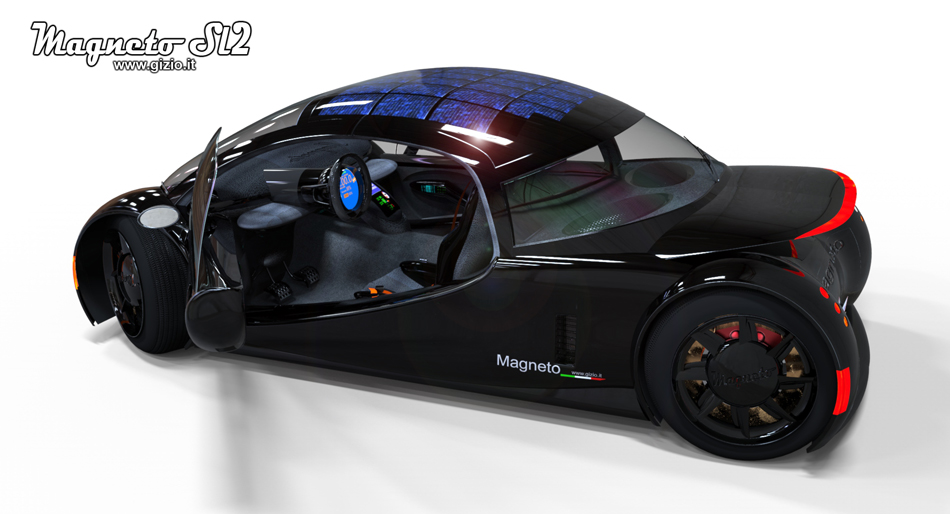
If you look at the architecture of your car today, it seem that almost nothing has basically changed; or if so, just few details emerged as new. Though electronics has a huge percentage in our car’s technology, on the other hand engines are indeed basically the same as they were more than one hundred years ago, with pistons and valves, oil, water and complex devices to keep it cooled from a large waste of energy still based on the combustion of fuel to get a very small percentage of useful energy.
Transmission as well all that mechanical complex stuff made of gears and levers, make cars still heavy and too complex; all that stuff hidden under the engine cowling doesn’t seem to be anymore a promise of modernity and freedom, and motors are ecological speaking unfriendly. Certainly if you look at the question through the lens of the “missed innovation” particularly in term of evolution of engines, it seems that only few important events happened within hundred years in the automotive environment like the large employment of electronics which increased only engine's performances and safety.
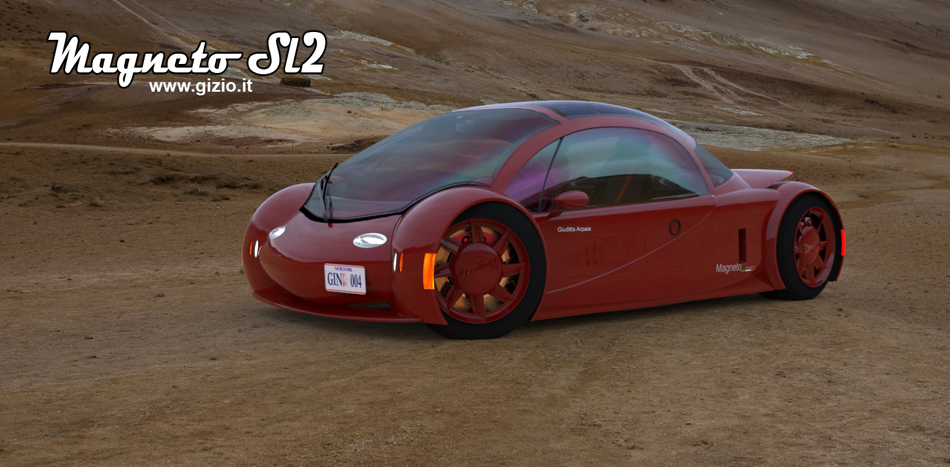
Hybrid technology today is mainly represented by a formula called parallel-hybrid, where a mechanic system made by a conventional endothermic motor and an electric one, both plugged to a common transmission are working either way to save fuel, or together to increase performance in acceleration.
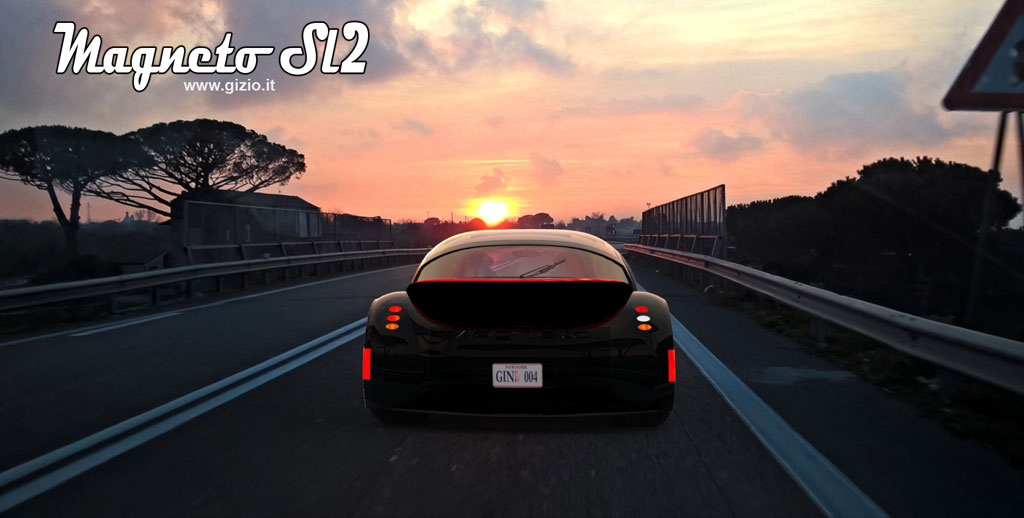
The news about parallel-hybrid typology after all, is basically due to a system that switch off the endothermic engine at the traffic light, restarting it later after the car has been driven firstly by the electric motors for few hundred meters or seconds, all that to save only a few drops of gasoline at the traffic light: and then? that’s all?
Since 1996 I spend my time to design hybrid system, or full electric machines, mainly addressed to a new aircraft's generation known as CellCraft, but also pointing my attention to some on-road vehicles as well, in both cases adopting a serial-hybrid technology, like the Magneto in the pictures, described along this page.
Magneto first issue was introduces in the 2008 published on this web site for the first time, however the project of that car goes back at the end of nineties having along the following years a coupple of revies according with the technology progress. Anyhow, since then the car was re-designed in some vital component, as well rethough particularly about electronics with a new software concept, introducing even more functions than of the first version, all that in order to increase the total performances.
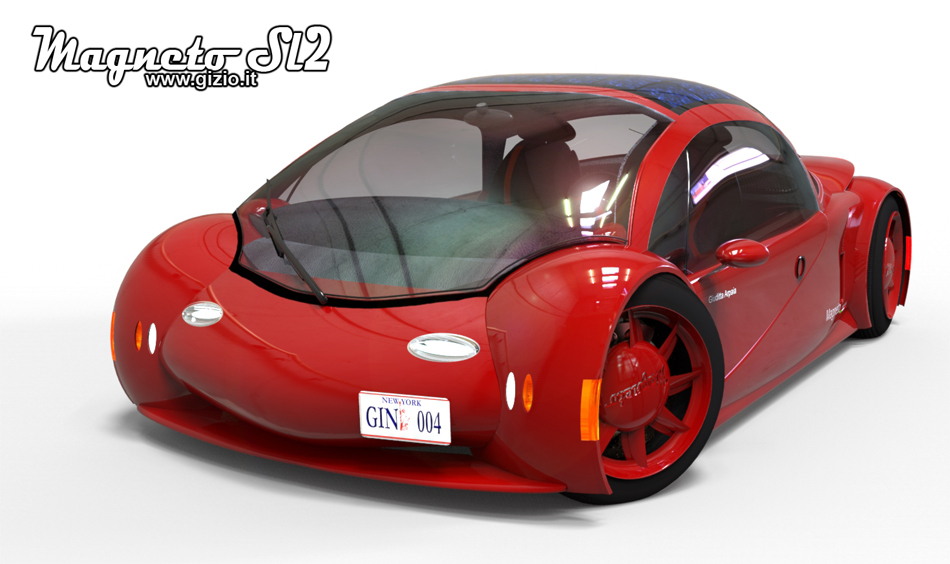
Endothermal engine architecture and performance
Maybe we might still wait some more time until we coul get a full electric car, capable to run for a long distance and be charged in short time or even seconds. However while waiting for that miraculous day we should develop a system that would be somewhere in the between: A car having a conventional new generation of endothermic engine, transmission less, provided only of a full electric traction, equipped with a high performance battery pack, but also charged through some more potential source of energy to keep batteries efficients and easy to charge like the induction charger I'm considering for this project, in other words using a wireless system to keep your car charged. But before talk about that, let’s take a close look to how a combustion engine works.
Despite
a car today is pretty much full filled of electronics components, this
seem to be apparently a quite big difference from the first vehicle
built more than hundreds years ago. Engine haven’t changed too
much since then. It’s a metal block with pistons, valves and spark
plugs, exactly as it was more thatn hundred years ago and it’s
still burning fuel to work. In other words the endothermic engine today
still in vogue isn’t too distant from the old vapor engine, which
also adopted a pistons and levers to move the vector.
Most of the energy introduced in the engine to get a mechanic activity,
is mainly lost in a thermal form of energy.

So the thermal energetic potential to move a piston up and down, with its complexity related to its own architecture is mostly lost in a very high percentage. An endothermic engine is after all something very close to a complex running-stove. In-fact it require an efficient cooling system to work, otherwise it would be rapidly damaged in the vital components because of very high temperatures that is developed along the combustion process.
All
that complexity, must power a heavy transmission system, that takes roughly
30 percent away from the total available energy already
produced by the engine to move the car along the way. This is the best
case of a TurboDiesel engine.
But only an average of 70% of the available power goes
straight to the wheels, since the endothermic engine doesn’t take
full advantage of all the thermal energy coming out from the combustion
process, because transmission and mechanical component are heavy and produce
friction. Then the real amount of productive energy is less than30%
in the best condition; the remaining 70 percent is definably
lost forever in heating.
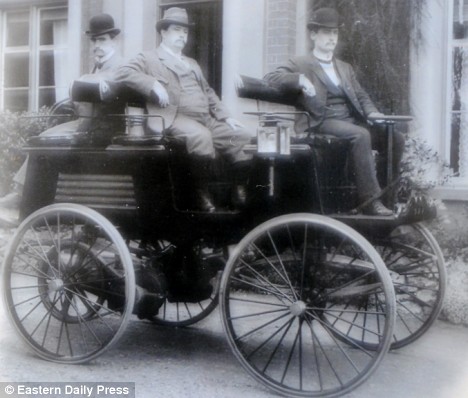
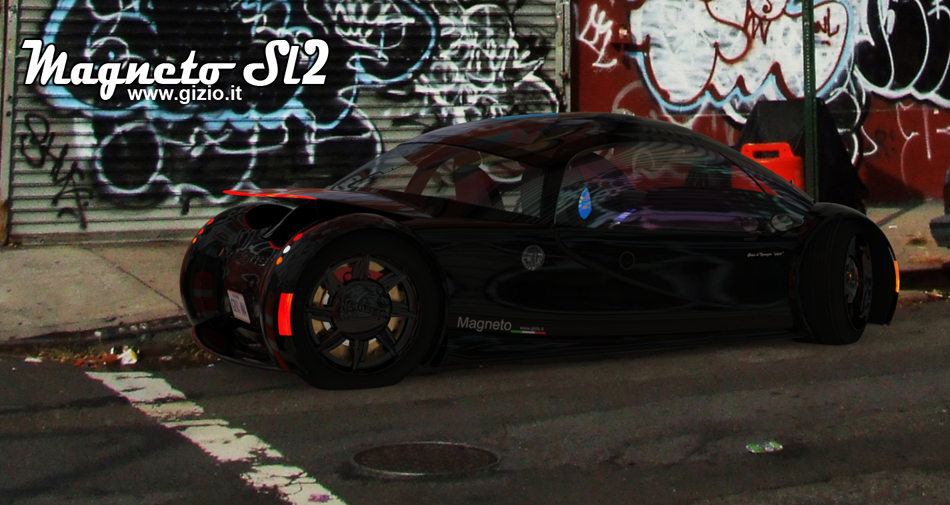
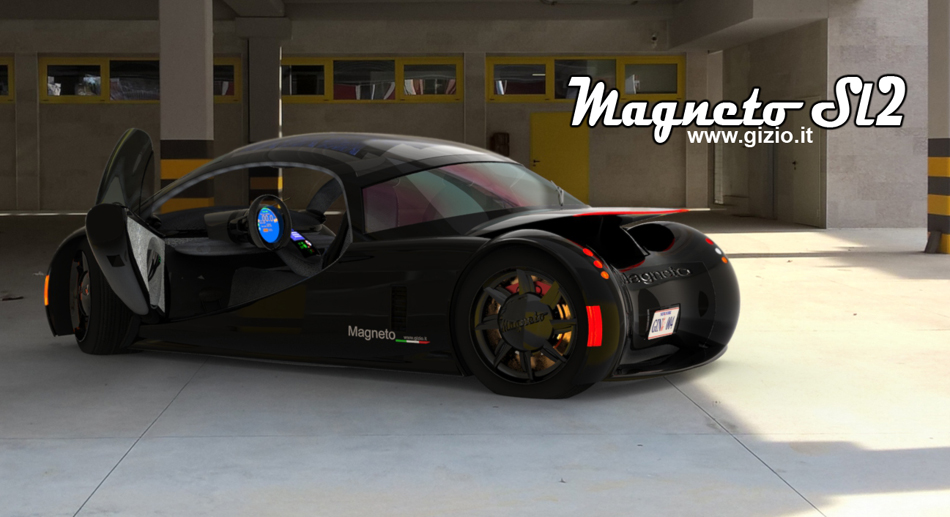
In the
second half of the 90’s the automotive industry
issued a series of prototypes, followed a decade later by a massive
industrial production of a new type of car. The basic idea were to built
a vehicle that would run either through a conventional endothermic engine
or with an electric motor. In terms of fuel consumptions this type of
vehicle is with no doubt affordable and interesting, however cars like
these are still equipped with heavy transmission, complex gearboxes;
therefore the electric traction isn’t very performing at all.
Also a car like this is very heavy, even more than a conventional vehicle,
because of the on-board battery pack weight added to the conventional
mechanics component as the main transmission gearboxes and its miscellaneous.
The electric traction is limited to a bunch of minutes, from the start
to a certain running time or speed, like the Toyota Prius, then and
only after that point the system will re-start the endothermic engine
making the car basically working as a conventional vehicle.
Therefore the innovation is only apparently new, or if you like pretty
much limited if compared to what we should be expected by the nowdays
(already) available technology. From my point of view all this doesn’t
seem to be yet a very attractive perspective in term of auto-motive's
industry revolution. We certainly should do a lot more than just run
the car through a small electric motor for a very short lapse of time
There are several kind of parallel-hybrid combinations. In other case
in-fact the electric motor works according with the endothermic engine,
helping it to increase its own performance; like in acceleration.
The basic idea for this type of hybrid combination remind me that applied
on those electric bikes, equipped with an electric motor helping the
biker easily climbing along a ramp, reducing dramatically the muscle
work.
At
the moment there is no other way to get some other form of energy out
from the combustion process than mechanic.
In the beginning of the car's history, cars were mostly electrics. Thomas
Parker was its first inventor, Ferdinand Porsche
instead introduced first this typology of vechicle on the market since
those early days. Electric motors were replaced later by the combustion
piston engine; those we call today endothermic engines. In the 20’s
oil was largely produced and cars were capable to run for an undefined
distance with combustion engines, while electric cars were still too
limited to the charging time, as well to the distance due to a short
endurance.
The
full electric car seems to be far away from the common imaginary perspectives,
and that not only due to the limitation of battery’s endurances,
or by any other technologic development, but rather due to the economic
politics of the oil market today in 2008. The oil price
seems to increase day by day keeping the car industry in a sort of confined
limbo, impeding any further innovation to save fuel. Fortunately reducing
gas consumption is against their idea of market benefit, but contradictorily
insisting with combustion engines. All that have a big impact in our
ordinary life, since we all depend by transportation.
The Parallel Hybrid’s idea is basically something
like a strange mechanic combination, a new way to connect two technological
worlds, the past through the conventional endothermic engines, and the
future with electric motors, altogether in order to increase performances
and save fuel and this could be a good - even if temporary
- answer to our transportation problems and constant needs, but not
the last one.

There is a new chance about hybrid technology.
Some auto makers like Volvo and recently Chevrolet
with a model called Volt, are already working from a long time to a
new way to conceive a brand new hybrid idea; I call this concept: serial
hybrid. Actually Chevrolet introduced on the international
market his model called Volt, a very new way to built cars, a new revolutionary
combination between endothermic engine and electric applications, they
call this formula Extended Electric Vehicle. Unfortunately
some “problems” caused unjustified criticism about this
car, probably because it is capable of a very good performances. This
car however is opening a new way to think about transportation, both
in term of technology innovation as well making a low fuel consumption
vector.
Let's have a closer look to what really means Serial Hybrid
car, what is it? how it’s made and what the real advantages of
such technology in transportation.
A Serial
Hybrid car doesn’t
have any transmission, the engine is just connected to an electric generator
which produce only electric power. The car is provided of four electric
motors, (settled in the wheels in the Magneto), so the traction
is full electric. A computer system provide to distribute the right
amount of electricity coming out from the engine-generator to power
two or even four electric motors(Magneto). Furthermore the car is also
provided of a battery pack that can make it running for an extensive
amount of time, without the use of the endothermic engine. So the weight
and the space that was once of the useless and heavy transmission is
now of the battery pack. This type of Car “today” can run
only if powered either by the endothermic generator, or through the
energy stored in advance in the battery pack. The battery pack can be
charged both through a conventional AC plug, or through the main on
board generator along the run, and the Chevrolet Volt seems to work
exactly like that. This is basically my idea about Magneto's
project.
A such type of car uses the combustion engine only to produce the electric
power, necessary to run the four electric in-wheel-motors.
Since there is no transmission - low friction – or heavy complex
gears, shaft, etc. The engine will be a bit lighter than those installed
in a parallel car type. Since transmission - as I’ve already wrote
above - absorb at-least a 30% of the total power
from the endothermic engine in a parallel hybrid system, all that with
a noticeable increasing in fuel consumption. Serial
Hybrid cars instead do
not need to have a big engine, and the piston’s volume can be
radically reduced, allowing an interesting low fuel consumption, since
it worsk just as an electric generator because is directly connected
to a generator with no gears in the between.
MAGNETO
is based on a simple idea! The car is provided of four electric motors,
each one settled in each single wheel. The motors are a three
phase type brush-less, controlled via a digital
processor. The four wheels are all steering, even though there is a
noticeable difference in the angle of those in the front, from those
in the rear, which can turn within an angle not wider that 5 degrees
(Back) ; this adaptation increase maneuverability in both low speed
and at high speed.
The gas engine is a Turbo compressed engine type built with Ceramic
components, Teflon and special metal alloys
elements, it is also very compact and thermodynamically better efficient
than a conventional one. It can run by alcohol, unleaded fuel, or methane
gas, or in the SlD version with Bio Diesel
fuel. The motor is provided of a radiator shared with the oil
cooling system, most of the heating can be processed through some special
Peltier’s cell pack, getting electricity from the thermal difference
between the engine heating and the external air.
MAGNETO has a kinetic system capable to accumulate
energy while breaking, furthermore the four electric motors work also
as generator while the car run free by inertia, or if pushing his feet
on the brake pedal. Finally a small solar panel on the roof provide
an affordable source of energy, keeping the service battery charged
during the day time. In a different programmed mode however the solar
panel could power the air conditioning system, when the external temperature
isn’t convenient for the passenger, keeping the entire cockpit
in a constant good ventilation and temperature.

In the front side of the vehicle there is a Pendelev generator, or magnetic engine. It’s a simple machine which is based on the pushing force of two magnetos which are oriented toward with the same polarity on each in front to the other, with a special angle, or through a special mechanism. It’s well known that a repulsive force make magnets having the same polarity be reciprocally repulsive from each other. The repulsive force if well controlled electronically and can provide a spinning of the rotor through the action of magnetic (repulsive) force.
Magnetic generator is made of two main components, a fixed cylinder called stator, which contain magnetos oriented with an angle of almost 30 degrees, with a variable angle according with the speed of the rotor. The mechanism keeps all the magnets in a constant conflict due to the magnetic repulsive force. One of the motor type I choose is made by two main cylinder, in this type all the magnets are pointing in to the cavity of the stator. The second component is the rotor which contains the same amount of magnetos also oriented against to magnets settled on the stator.
The pushing or repulsive force between the magnetos existing on both sides of the stators and the rotors, makes the rotors spinning. Since the main shaft is provided of a disk mass, a flywheel, it keep the rotor turning moving its magnetos facing with to the next on the repulsive one on the stator and so on, in an endless rotation keeping the rotor in a constant revolution and dynamic status. If the system is connected to a small generator, we may get a noticeable amount of energy that combined with the other sources can be directed straight to the batteries, keeping them permanently charged.
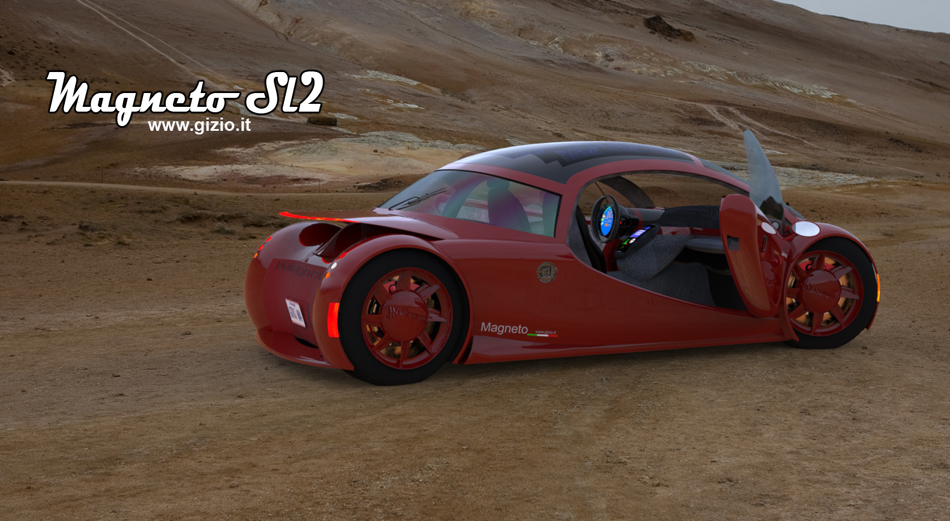
Magneto is mainly
made with recycled aluminum and light plastic. A steel frame sustain
the body; the battery pack; the generator on the rear and the Magnetic
motor in the front. The centre of gravity of the vehicle is very low,
like a sport car. The car is also provided of dynamic dumpers controlled
by an electronic stabilizer device, and they remind in some way those
employed on a formula one car.
The cockpit is pretty wide accommodating for two: Driver and passenger,
but there aren’t levers or button to push or pull, everything
can be activated only through two main touch-consoles, respectively
placed one on the right side of the pilot seat and the other at the
centre of the driving steer.
The main steer driving display works also as main service panel. All
the main information are also displayed on the front driver portion
of the windshield, the car has also a sort of night vision system. The
windshield is provided of very thin solar cells surface, capable to
maintain a constant temperature inside the cockpit according with the
external temperature.
The driving steering is provided of a finger-ID device,
allowing the driver to be recognized by the vehicle, pilot can recall
all the personal setting he/she programmed in advance for his/her own
personal comfort, like position of the seat, driving style and many
other options. The seats are from those aboard the CellCraft.
Style
The body’s shape remind a car of 50’s with a smooth and sexy shape, but at the same time having a contemporary shadow of style. I think as industrial designer that a good combination between classic and modernity in term of style, would be the right logical solution to design a funtional object; in this case a nice two seat sport car having a some intriguing vintage look. Recently many car’s brand are reconsider old model which literally wrote the history of classic car, re-styling some of their old model, expecially those from the 60's and 70's in with a new look that reming the original version of early decade, reminding the classic car of the past. MIni, and Fiat 500 are some example of that. I love the American design and some European car design of the past and I believe that many other concepts could be developed having as reference point the old and timeless car design of the past.
MAGNETO
as well as all the other projects of mine is a sort of conceptual derivation
from most of my aeronautic projects, since I spent most of my time as
aircraft designer, developing new concept and ideas. Aerodynamic is
very important for me as well as any interesting technology available
in the next future intended to saving fuel as well increasing performance.
MAGNETO indeed is provided of high power LEDs
for the external illumination, both the doors are provided with a steal
band and side airbag. Doors can be either opened or closed through vocal
commands as well through the cockpit side pad, but they can be activated
also at a certain distance with a sort of remote control that remind
in some aspect the Flight-Card which all CellCrafts
are equipped with; a sort of a complex and multifunction electronic
card.
Any of the available functions or operations the car is capable to perform
can be activated both through vocal command or either through the central
or front touch screen. Vocal command can be added or removed, extending
the possibility of multiple tasks, making your MAGNETO unique
and pretty much different by any other on the road. Many are the innovations
inserted in this running object, but more import is the possibility
to drive a very super ecological vehicle capable of high performance
with a very low fuel consumption.
Performance is a very interesting frame of what I’m depicting
about the MAGNETO. The maximum speed is 250
Km/h (155 Miles/h). The consumption is very low, according
with the very high performance due to the relation between performance/consumption
of the power generator, capable to run for a medium average of 35
km/Litre, and the average battery’s autonomy of 120
km at medium speed of 120 km/h, makes this vehicle capable
to run for over than 60 Km per litre. Differently by
the Chevy Volt, MAGNETO is provided with a self charging
system, since the on-board battery-pack can be charged while running
by the engine-generator, saving some of the energy coming from the endothermic
engine.
MAGNETO
is a very sport car and the same technology can be applied to any other
vehicle, indeed a such formula can have an interesting impact on the
style, on the architecture of the vehicle itself as well to our concept
of modern transportation. Most of all; the big difference is due to
the relationship between consumption and performance that as matter
of effect makes a vehicle like this highly innovative for our times,
and this seems to be the most radical and evident changes.
Automotive industry should develop even more prototypes like Magneto,
experimenting new technologies replacing new concept on the market soon
time by time according with electric motor and batteries evolution;
a deep change of view, not only in terms of the equation: performance/consumption,
but also considering a consistent impact on the environment that a vehicle
like this could have in our ordinary life. What makes an idea like this
quite interesting is also the cultural aspect, hoping at-least useful
for a brand new input related to the mobility concept at least until
electric cars became the present.
Conclusions
My
projects are pure creative exercises, however I do like to work on real
possibilities; I prefer to think to what it can really be built or made,
rather than follow strange concepts or impossible views, like gravitational
cars or science fiction stuff like that.
Future is a sort of multi-dimensional form, and the way it could move
forward is off-course of my interest because of its characteristics
can change the course suddenly at any time, and that makes me feel frequently
excited almost every time I start a brand new project. I do like to
put on a common plane a combination between high technology and environment,
since I do believe that the two concepts are strictly belonged.
Today’s technology allows private builders, as well high tech
industries, to develop projects even more in advance in the time of
the position of my MAGNETO, but as I’d already
said international interest are dramatically resisting to a such technological
developments.
In
the next future the use of fossil fuel will be unusual and inconvenient
and it will be considered quite dangerous. Whoever own a very old combustion
engine car should be in posses of a special permission to make his/her
own old fashion vehicle running on the road, where combustion engine
has already disappeared from long time before. Therefore burning fuel
to move from point A to point B will be considered a very dangerous
and inconvenient illegal activity.
Think about, what makes very strange our time however “by this
point of view”, is that today in most of European countries using
vegetal oil in our diesel engines is absolutely ILLEGAL and FORBIDDEN!!
Vegetable oil has a very low impact on environment, and can be made
out of that oil adopted in the food industries, or any other kind of
activity which employ this vegetal fluid for food, like restaurants,
fast food etc, and I'm not talking of fresh and clean oil, but rather
of exhausted oil. The situation instead is very paranoid since governments
impose by law the use of fossil gasoline, which is very toxic, and today
even more expensive.
If I want to built a car like this; like the MAGNETO,
I would probably be forced to export my idea somewhere else but in Italy,
since the country’s politic has a strong conservative influence
in our economy, and that would make my projects quite impossible to
be developed here.
Thanks to all the available know-how and technology progress occurring
throughout the world, we should increase the quality of our life easily
and fast, and mobility is one of our main concerns; we can do it, now!!
Technology is belonged with almost any segment of our society, and we
all are tighten in a sort of complex network and in so many ways, despite
all the economic and politic asset form, or wherever you are doing in
the world.
Gino D’Ignazio “gizio” Feb 2008